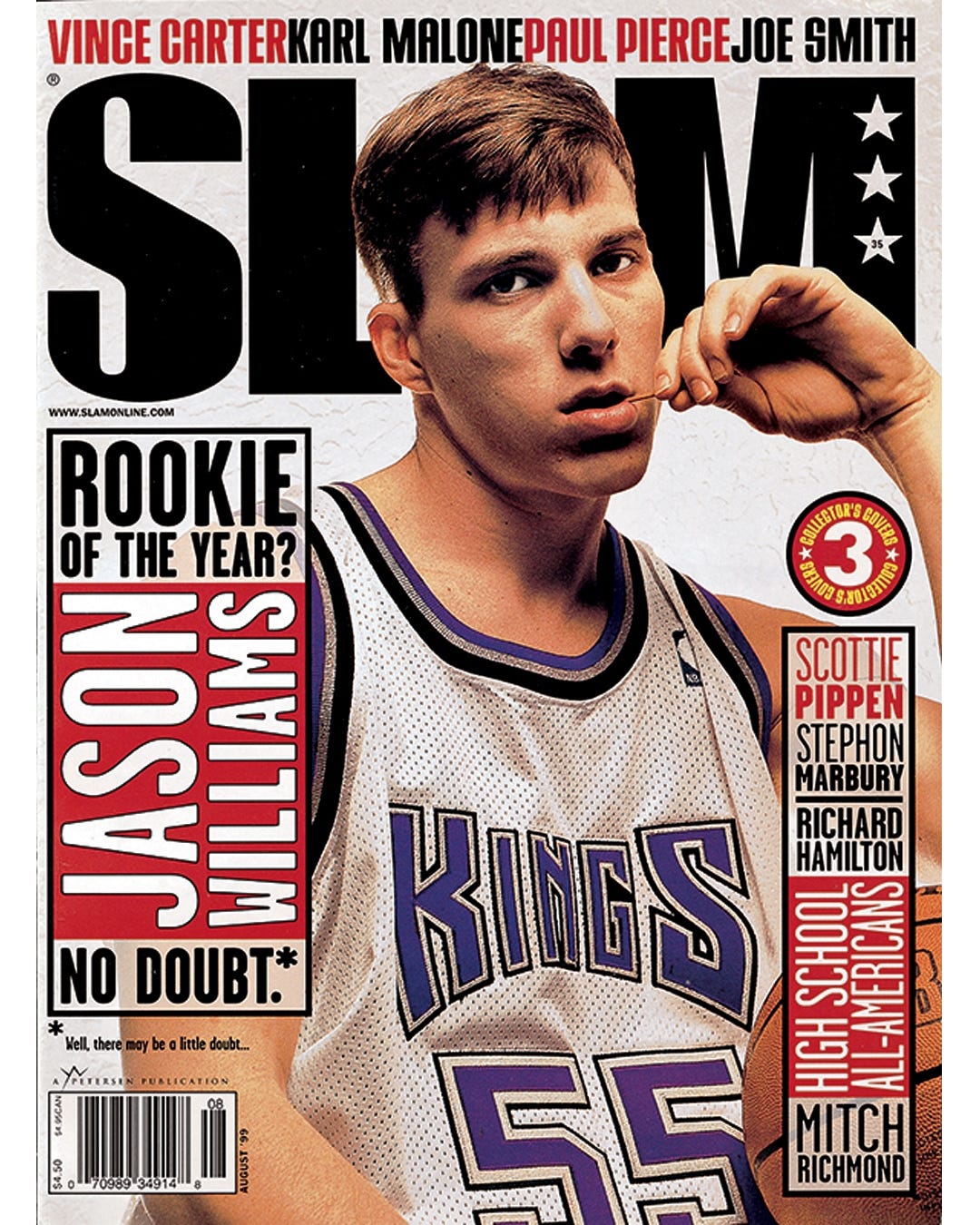The Greatest Mixtape Ever, Vol. 2: Jason Williams
The Press Break noted last week just how much ESPN left on the table when it gave filmmakers Set Free Richardson and Chris Robinson less than 48 minutes in its coverage of the And1 Mixtapes. Well, another example hit me this week: Jason Williams.
Every few months on Twitter, an account posts a new compilation of the point guard’s highlight-reel plays. That includes the below, which an online friend shared.
Coincidentally, the topic of Williams came up between pick-up basketball runs at my local Y just last week. Williams is the ultimate anomaly when it comes to NBA nostalgia. Other players who get frequent social-media highlight packages or come up in casual conversation include Hakeem Olajuwon, Charles Barkley, pre-Lakers Shaq — all of whom are Hall of Famers and former MVPs.
Even someone like Shawn Kemp, whose superhuman dunking remains as astounding today was it was in real time — the “Lister Blister” turned 30 last month and remains one of the most remarkable in-game slams I’ve ever seen — was, at one time, a top 10 player in the NBA.
Jason Williams was one of the NBA’s most exciting players at his peak, but never All-Star caliber. The Sacramento Kings went from being a fun team with a low ceiling before trading Williams for the more traditional playmaker Mike Bibby, for example.
He was never an NBA All-Star, and his peak arguably came as a veteran role player for the 2006 Finals-winning Miami Heat.
Hell, Jason Williams wasn’t even the best point guard named Jason Williams in the same era he was stockpiling future YouTube content: The Duke product sharing the moniker was putting the final touches on a potential top 100 all-time college career the season in which Sacramento shipped its Jason Williams to Memphis for Bibby.
But all that serves to further reinforce how incredible it was for Williams to have such lasting influence.
Let’s get into by stating the obvious yet uncomfortable upfront: Much of Williams’ popularity at the turn of the millennium and his enduring legacy is owed to his being white.
Before you get the wrong idea, this isn’t a Vichy Deadspin-inspired hit piece decrying Williams or his fans in an ill-conceived-and-even-more-poorly-executed attempt to appear that I’m an ally. I am instead presenting a fact that I’m qualified to speak on because I lived it.
As mentioned in last week’s installment on The Greatest Mixtape Ever, SLAM held a special place in my youth and proved highly influential on my basketball and pop-culture tastes. Despite seeking out the clothes and gear advertised in the publication, and hitting up Columbia House to order the CDs of artists shouted out in its pages, I still felt a particular excitement seeing someone who looked like me on the cover of SLAM in 1999.
Look, I won’t mince words: I was a culture vulture before the label existed. But Jason Williams was not. On the contrary, Williams had the natural panache and the bona fides I never could, which made him cool in a way I aspired.
That’s why his poster graced my bedroom wall. He provided the impetus for me to practice my no-look and behind-the-back passes, skills that helped me set some area and school assist records my senior year of prep.
I was never going to dominate the paint like Shaq or jump out of the gym like Vince Carter, but maybe I could be Jason Williams.
Culturally, Williams’ instant stardom as a rookie came at a serendipitous time. He was stealing the show on SportsCenter and garnering shouts in SLAM at the same time that Eminem’s Slim Shady LP bumped out of cheap sound systems in Hondas across Suburbia.
In the spring of ‘99, MTV had “My Name Is” on what seemed like an hourly loop, not unlike the nightly SportsCenter replays re-airing Williams’ breathtaking passes during the lockout-shortened season.
Eminem’s appeal mirrored that of Williams in my part of the world. Both had a coolness that couldn’t be manufactured. There was nothing phony or corny about their swagger. Each also boasted endorsements that carried true cultural weight.
Eminem, of course, stormed onto the scene with a co-sign from hip-hop luminary Dr. Dre.
In 1999 alone, Aftermath Record’s empresario made a cameo in the smash-hit “My Name Is” video, collaborated fully on the follow-up “Guilty Conscience” — which includes Em referencing Dre’s brutal attack of Dee Barnes — and Em provides the chorus on Dre’s mega-hit from the Chronic 2000 album, “Forgot About Dre.”
Likewise, Jason Williams gained instant credibility from his childhood friendship with another fast-rising star at the turn of the millennium, Randy Moss.
Only Nike’s market team of the time could make The Dukes of Hazard theme seem as cool as “Forgot About Dre.”
In addition to the Moss co-sign, Jason Williams was also part of the And1 Universe.
While Rafer Alston was indeed the only Mixtape talent to reach the NBA, he wasn’t the lone NBA’er to appear on a Mixtape. Williams — who sported And1 shoes early in his NBA career — is a focal point of the seventh edition Mixtape.
The point guard from West Virginia represents another dimension of the And1 influence on basketball culture. No matter why he was popular, Jason Williams was vital to growing both the mythos and ethos of the streetball style to an audience far beyond the courts of New York City.





